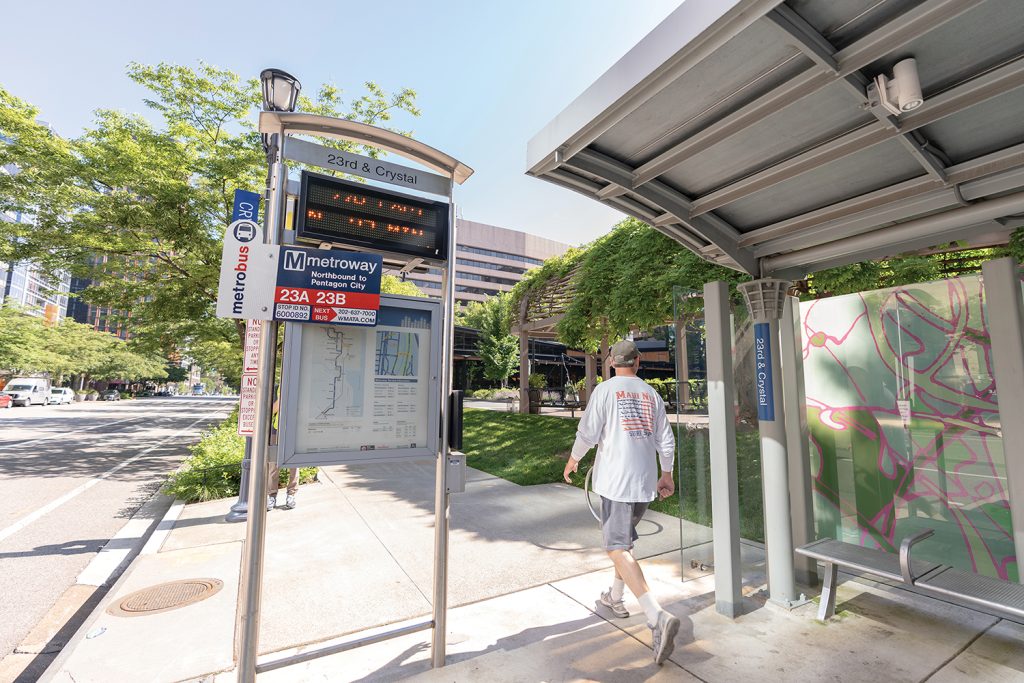Introducing the APTA Student Member Writing Challenge!
By Alyssa Pfluger Beyer | 10/3/2024
This year, APTA launched its Student Member Writing Challenge, giving APTA student members the opportunity to submit innovative and informative articles for possible publication in Passenger Transport. As the next generation of public transit leaders, the insights, perspectives, and opinions of APTA’s student members matter. Here, Passenger Transport proudly introduces its first challenge winner, Alyssa Pfluger Beyer!
Bus Rapid Transit: A Potential Solution to Today’s Transit Challenges
BY ALYSSA PFLUGER BEYER
Regional Transportation Planner
Northern Virginia Transportation Authority
Master’s in Urban Planning, San Jose State University, CA

Buses provide a flexible and relatively inexpensive public transportation option but remain largely non-competitive with private passenger vehicles. Bus Rapid Transit (BRT) networks offer a solution; however, their implementation faces logistical and political hurdles (Lindau, Hidalgo, and Lobo). Organizations such as the Northern Virginia Transportation Authority (NVTA) recognize the potential of BRT systems. Accordingly, NVTA is developing a Preliminary Deployment Plan (PDP) for a regional BRT system in Northern Virginia that aims to address transit challenges and reduce vehicle dependency and congestion.
David Miller, chief development officer at Foursquare Integrated Transportation Planning and a consultant for NVTA, shares that the main barrier to ridership is straightforward. “Published peer reviewed research, and reoccurring national surveys… have consistently demonstrated that convenience is the most critical element to increasing ridership. Over everything else, users want frequent, reliable, and fast bus service [and these improvements lead to increased ridership].” In addition, concerns about safety, ease of use, comfort and accessibility, and social stigmas also play a role in bus system success.
Speed. Most bus transport systems use the same roadways as private passenger vehicles, which provides much of their flexibility but limits their speed. Technological solutions, such as Transit Signal Priority (TSP) and queue jumping, can improve bus speeds at intersections. Impacts from these solutions can vary, but may provide an edge over the travel times of private vehicles. (Ngan, Sayad, and Abdelfatah).
A more impactful way to improve bus speed is through bus-dedicated transitways. However, the inclusion of bus lanes often requires either the expansion of a road or the conversion of an existing traffic lane, the latter of which can have negative impacts on adjacent travel lanes. (Abdelfatah and Abdulwahid). Nevertheless, a consistent network is necessary for a competitive BRT system. Dalia Leven, national planning lead for transit and shared mobility at Cambridge Systematics, Inc. shares, “The biggest challenge to building consensus is on how to allocate limited roadway space between a wide range of stakeholders. Competing needs… can make agreeing on dedicated space for transit a real challenge. Any one concession doesn’t slow the BRT too much, but they add up quickly and can result in BRT that doesn’t offer the speed or reliability necessary in order to really compete with driving.”

Reliability. In addition to speed itself, travel time reliability is an important component of increasing (or maintaining) ridership. (Sterman and Schofer). The inclusion of Real Time Information Systems can improve satisfaction and reduce reliability related anxiety for riders, leading to increased ridership. (Brakewood, Barbeau, and Watkins) and (Shi et. al). Adding an auditory component can also vastly improve accessibility for vision-impaired riders. (Bentzen, Crandall, and Myers). While providing information about a delay can decrease negative responses to it, improving reliability by reducing travel conflicts is vital to ensuring the satisfaction of riders. (Perk, Flynn, and Volinski).
Frequency. Service increases to low-frequency routes produce a greater increase in ridership than that of already high-frequency routes. (Berrebi, Joshi, and Watkins). While the benefits of increased frequency are variable, BRT can increase ridership by providing shorter route headways.
Safety. In general, city buses incur lower injury rates than cars, not only “for vehicle occupants, but also for pedestrians and cyclists traveling along bus routes” (Morency et al.). Many potential riders, however, have real and perceived concerns about crime and personal safety on buses. This is especially true for young women, who have distinct concerns about sexual harassment and victimization on public transportation. (Loukaitou-Sideris and Natarajan et al.). Some of these fears can be alleviated through design, policing, security technology, and education/outreach strategies available through a BRT model, such as improved lighting, staff visibility, and training. (Ceccato, Langefors, Näsman).
Ease of Use, Comfort, and Accessibility. Bus and bus stop amenities range from non-existent to extensive, and their inclusion is positively associated with higher ridership. (Shi et. al). BRT systems often boast a more extensive list of amenities, which can improve wayfinding, multimodal connections, boarding, and fare payment, and thus improve the rider experience.

Clear wayfinding, which vastly improves ease of use, is often lacking in traditional bus systems. (Farr et al.). Wayfinding tools are often limited to small, static signs on posts, and electronic displays on buses, which can be easy to overlook, provide limited information, and are not accessible to all riders. Increased visibility of bus stops and updated signage design can increase transit ridership. (Benesh et al.)
The inclusion of multimodal transportation connections improves ease of use and access to bus systems. It is especially important to include active transportation connections to BRT systems, as bus systems with higher frequencies and speeds are more attractive to cyclists. (Brand, Hoogendoorn, van Oort, and Schalkwijk).
The boarding experience also impacts ridership. Traditional boarding requires a step up onto the bus from street or curb level, with ADA ramps for wheelchair users. However, using a ramp is time intensive and can be difficult for those with manual wheelchairs. (D’Souza et al.). In addition, riders with disabilities may find it hard to request assistance due to lack of infrastructure and negative experiences. (Das Neves,Unsworth, and Browning). At-grade boarding can make using buses much more appealing for mobility-impaired individuals. It also allows for all-door boarding from individuals of all mobility levels, which in turn can reduce dwell time. (Murray).
Fare payment is another aspect of ease of use. Off-board fare collection, as seen in rail stations, is often less costly for operators and can improve the ticket buying experience, expedite boarding, and increase bus speeds. (Tirachini and Hensher) and (Tirichini). In addition, acceptance of multiple payment methods (cash, credit card, transit pass, and app) can improve accessibility and equity, and fare integration with other transit modes increases ridership. (Brakewood), (Sharaby and Shiftan), and (Ko, Kim, and Etezady).

Social Stigma. Physical changes to a transportation system may encourage ridership, but there is a more pervasive issue at play. Public transportation, particularly via bus, is often stigmatized. (Hazelton-Boyle and Wellman) and (UNC Charlotte Urban Institute). This stigma arises from “a connection between -public transport, poverty, and inefficiency that must be broken.” (Bromley et. al). Improving transit conditions while maintaining affordability can combat this stigma. BRT systems are a cost–effective option for providing such improvements; it provides an “opportunity to showcase improvements in public transit service and, in many instances, enables improvements that would otherwise not be affordable or cost-effective in the context of lower-density transit markets.” (Polzen and Baltes). Younger generations may also be more receptive to BRT systems. They, Miller shared, “are less likely to drive, … delay even getting a license for many years, and are much more likely to be willing to use apps to plan trips, consume information, and pay for transit.”
Conclusion
Integrating BRT into a transportation network can encourage ridership by overcoming many of the barriers to traditional bus systems, such as speed, reliability, frequency, safety, ease of use, comfort, accessibility, and social pressures. While BRT systems can face difficult implementation challenges, they still prove to be a promising solution. Looking forward, projects such as NVTA’s PDP provide a detailed analysis and example of what BRT can look like in our communities.
(Lindau, Hidalgo, and Lobo): https://www.sciencedirect.com/science/article/abs/pii/S0739885914000675
(Ngan, Sayad, and Abdelfatah): https://www.sciencedirect.com/science/article/pii/S1077291X22003927
(Sterman and Schofer): https://ascelibrary.org/doi/abs/10.1061/TPEJAN.0000548
(Brakewood, Barbeau, and Watkins): https://www.sciencedirect.com/science/article/abs/pii/S0965856414002146
(Shi et. al.): https://www.sciencedirect.com/science/article/pii/S2590198221000300
(Bentzen, Crandall, and Myers): https://journals.sagepub.com/doi/abs/10.3141/1671-04
(Perk, Flynn, and Volinski): https://rosap.ntl.bts.gov/view/dot/17020
(Berrebi, Joshi, and Watkins): https://www.sciencedirect.com/science/article/pii/S0965856421000604
(Morency et al.): https://www.ncbi.nlm.nih.gov/pmc/articles/PMC5906382/
(Loukaitou-Sideris): https://link.springer.com/article/10.1057/sj.2014.9
(Natarajan et al.): https://link.springer.com/article/10.1057/s41300-017-0025-4
(Ceccato, Langefors, Näsman): https://www.idunn.no/doi/full/10.1080/2578983X.2021.1882744
(Shi et. al.): https://www.sciencedirect.com/science/article/pii/S2590198221000300
(Farr et al.): https://www.tandfonline.com/doi/abs/10.1080/01441647.2012.712555
(Benesh et al.): https://conservancy.umn.edu/bitstreams/bdb717e4-64f1-429d-ad1e-4bd6d45b848b/download
(Brand, Hoogendoorn, van Oort, and Schalkwijk): https://ieeexplore.ieee.org/abstract/document/8005612
(D’Souza et al.): https://www.tandfonline.com/doi/abs/10.1080/17483107.2017.1401128
(Das Neves, Unsworth, and Browning): https://www.tandfonline.com/doi/full/10.1080/17450101.2022.2126794#abstract
(Murray): https://escholarship.org/uc/item/4jq618k5
(Tirachini and Hensher): https://www.sciencedirect.com/science/article/abs/pii/S0191261511000208
(Tirichini): https://www.tandfonline.com/doi/abs/10.1080/18128602.2010.520277
(Brakewood): https://dspace.mit.edu/handle/1721.1/60796
(Sharaby and Shiftan): https://www.sciencedirect.com/science/article/abs/pii/S0967070X12000169
(Ko, Kim, and Etezady): https://ascelibrary.org/doi/abs/10.1061/(ASCE)UP.1943-5444.0000506
(Hazelton-Boyle and Wellman): https://journals.sagepub.com/doi/abs/10.1177/1087724X221088859
(UNC Charlotte Urban Institute): https://ui.charlotte.edu/story/overcoming-stigma-riding-bus#:~:text=Local%20officials%20have%20been%20talking%20for%20years%20about,according%20to%20CATS%20statistics%20from%20a%202017%20study.
(Polzen and Baltes): https://www.sciencedirect.com/science/article/pii/S1077291X22004283